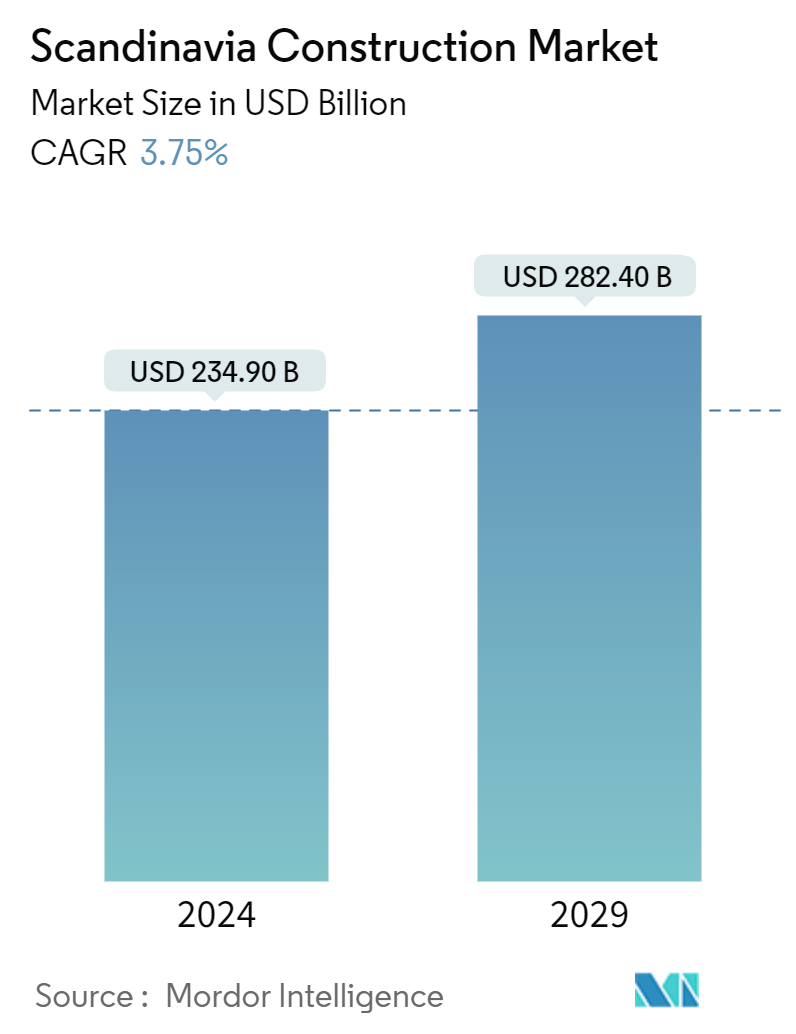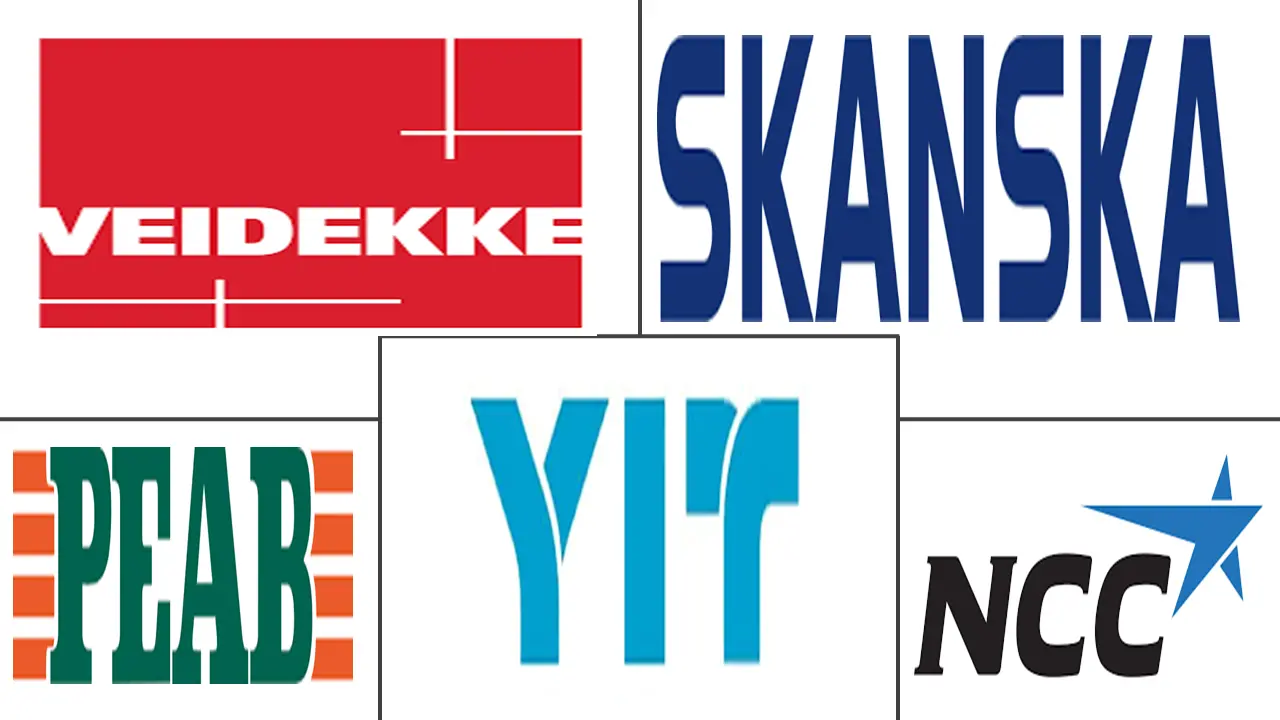Market Size of Scandinavia Construction Industry

| Study Period | 2024 - 2029 |
| Base Year For Estimation | 2023 |
| Market Size (2024) | USD 234.90 Billion |
| Market Size (2029) | USD 282.40 Billion |
| CAGR (2024 - 2029) | 3.75 % |
| Market Concentration | Medium |
Major Players
*Disclaimer: Major Players sorted in no particular order |
Scandinavian Construction Market Analysis
The Scandinavia Construction Market size is estimated at USD 234.90 billion in 2024, and is expected to reach USD 282.40 billion by 2029, growing at a CAGR of 3.75% during the forecast period (2024-2029).
By 2030, the EU Commission estimated that there could be an additional 160,000 green jobs in the construction sector. In addition to current trends and developments in the industry, national legislation and policy focus have shown that sustainable buildings are now a priority construction area in Denmark.
In 2023, Sweden's economy was indicated to shrink with increasing interest rates and inflation, reducing private consumption, falling house prices, and a sharp slowdown in construction activity. In 2022, when real GDP growth slowed to 2.6%, the economy started to feel the impact of higher energy prices and inflation. In line with the evolution of the European electricity market, Sweden's electricity prices have increased despite a high share of domestic renewable energy production.
In Norway, formal regulations governing the reuse of building materials include the documentation of construction products (DOK) and the technical requirements for construction works (TEK17). The DOK and TEK17 set out construction structure requirements for building material turnover. The National Strategy for a Green and Circular Economy seeks to double secondary raw material use in the next 10 years to contribute to the UN's sustainable development goals. The approach is still experimental, given the methodological and cost considerations, although some pilot projects in Norway have shown high material reuse. To systematically map, dismantle, store, and prepare materials for reuse in existing buildings, it is essential to design new buildings. To this end, significant changes in the treatment of current structures and materials and the design and procurement of new buildings are needed.
Scandinavian Construction Industry Segmentation
Construction is the installation, maintenance, and repair of buildings and other stationary structures, as well as the construction of roadways and service facilities that form fundamental components of structures and are required for their operation. Construction encompasses the processes involved in constructing buildings, infrastructure, industrial facilities, and related operations from start to finish. A complete background analysis of the Scandinavian construction market, including the assessment of the economy and contribution of sectors in the economy, market overview, market size estimation for key segments, and emerging trends in the market segments, market dynamics, and geographical trends, and COVID-19 impact, is covered in the report.
The Scandinavian construction market is segmented by sector (residential, commercial, industrial, infrastructure (transportation), and energy and utilities) and country (Denmark, Sweden, and Norway). The report offers market size and forecasts for all the above segments in value (USD).
| By Sector | |
| Residential | |
| Commercial | |
| Industrial | |
| Infrastructure (Transportation) | |
| Energy and Utilities |
| By Country | |
| Denmark | |
| Sweden | |
| Norway |
Scandinavia Construction Market Size Summary
The Scandinavian construction market is poised for growth, driven by a focus on sustainable building practices and infrastructural investments. Denmark is prioritizing sustainable construction, with national policies emphasizing the development of green buildings. Meanwhile, Norway is advancing regulations to promote the reuse of building materials, aligning with global sustainability goals. Despite economic challenges in Sweden, such as rising interest rates and inflation impacting private consumption and housing prices, the construction sector remains a critical area of focus. The market is characterized by a few dominant players, including Skanska Sverige AB and NCC Sverige AB, who hold significant market shares. The competitive landscape is expected to evolve with increased construction investments and major projects on the horizon.
In Denmark, the transport infrastructure sector is experiencing growth, with strong investments in railways and a steady demand for construction activities. The market is also seeing a rise in construction investments across various sectors, including power stations, water treatment plants, and telecommunications. However, the housing sector has faced challenges, with a notable decline in housing construction activity and a decrease in housing permits and starts. Despite these challenges, the market is expected to expand, supported by ongoing and upcoming projects such as the Stockholm Wood City in Sweden and the Nordo development in Copenhagen. These developments highlight the region's commitment to innovative and sustainable construction practices, positioning the Scandinavian construction market for continued growth.
Scandinavia Construction Market Size - Table of Contents
-
1. MARKET INSIGHTS AND DYNAMICS
-
1.1 Current Economic and Construction Market Scenario
-
1.2 Technological Innovations in the Construction Sector
-
1.3 Insights into Costs Related to Construction and Building Materials
-
1.4 Impact of Government Regulations and Initiatives on the Industry
-
1.5 Spotlight on Prefabricated Buildings Market in Scandinavia
-
1.6 Brief on Real Estate Market and Key Real Estate Players
-
1.7 Insights into Services allied to Construction (Design and Engineering, Fit-out Services, Facility management, etc.)
-
1.8 Insights into Key Distributors/Traders of Construction Materials
-
1.9 Value Chain/Supply Chain Analysis
-
1.10 Impact of COVID-19 on the Market
-
-
2. MARKET SEGMENTATION
-
2.1 By Sector
-
2.1.1 Residential
-
2.1.2 Commercial
-
2.1.3 Industrial
-
2.1.4 Infrastructure (Transportation)
-
2.1.5 Energy and Utilities
-
-
2.2 By Country
-
2.2.1 Denmark
-
2.2.2 Sweden
-
2.2.3 Norway
-
-
Scandinavia Construction Market Size FAQs
How big is the Scandinavia Construction Market?
The Scandinavia Construction Market size is expected to reach USD 234.90 billion in 2024 and grow at a CAGR of 3.75% to reach USD 282.40 billion by 2029.
What is the current Scandinavia Construction Market size?
In 2024, the Scandinavia Construction Market size is expected to reach USD 234.90 billion.

